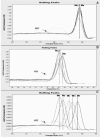Identification and quantification of archaea involved in primary endodontic infections
- PMID: 16597851
- PMCID: PMC1448633
- DOI: 10.1128/JCM.44.4.1274-1282.2006
Identification and quantification of archaea involved in primary endodontic infections
Abstract
Members of the domain Archaea, one of the three domains of life, are a highly diverse group of prokaryotes, distinct from bacteria and eukaryotes. Despite their abundance and ubiquity on earth, including their close association with humans, animals, and plants, so far no pathogenic archaea have been described. As some archaea live in close proximity to anaerobic bacteria, for instance, in the human gut system and in periodontal pockets, the aim of our study was to assess whether archaea might possibly be involved in human endodontic infections, which are commonly polymicrobial. We analyzed 20 necrotic uniradicular teeth with radiographic evidence of apical periodontitis and with no previous endodontic treatment. Using real-time quantitative PCR based on the functional gene mcrA (encoding the methyl coenzyme M reductase, specific to methanogenic archaea) and on archaeal 16S rRNA genes, we found five cases to be positive. Direct sequencing of PCR products from both genes showed that the archaeal community was dominated by a Methanobrevibacter oralis-like phylotype. The size of the archaeal population at the diseased sites ranged from 1.3 x 10(5) to 6.8 x 10(5) 16S rRNA gene target molecule numbers and accounted for up to 2.5% of the total prokaryotic community (i.e., bacteria plus archaea). Our findings show that archaea can be intimately connected with infectious diseases and thus support the hypothesis that members of the domain Archaea may have a role as human pathogens.
Figures




Similar articles
-
T-RFLP-based mcrA gene analysis of methanogenic archaea in association with oral infections and evidence of a novel Methanobrevibacter phylotype.Oral Microbiol Immunol. 2009 Oct;24(5):417-22. doi: 10.1111/j.1399-302X.2009.00539.x. Oral Microbiol Immunol. 2009. PMID: 19702957
-
Characterization of C1-metabolizing prokaryotic communities in methane seep habitats at the Kuroshima Knoll, southern Ryukyu Arc, by analyzing pmoA, mmoX, mxaF, mcrA, and 16S rRNA genes.Appl Environ Microbiol. 2004 Dec;70(12):7445-55. doi: 10.1128/AEM.70.12.7445-7455.2004. Appl Environ Microbiol. 2004. PMID: 15574947 Free PMC article.
-
Distribution of Archaea in Japanese patients with periodontitis and humoral immune response to the components.FEMS Microbiol Lett. 2008 Oct;287(1):69-75. doi: 10.1111/j.1574-6968.2008.01304.x. Epub 2008 Aug 14. FEMS Microbiol Lett. 2008. PMID: 18707623
-
Methanogenic archaea in subgingival sites: a review.APMIS. 2013 Jun;121(6):467-77. doi: 10.1111/apm.12015. Epub 2012 Oct 19. APMIS. 2013. PMID: 23078250 Review.
-
Meta-analyses on the Periodontal Archaeome.Adv Exp Med Biol. 2022;1373:69-93. doi: 10.1007/978-3-030-96881-6_4. Adv Exp Med Biol. 2022. PMID: 35612793 Review.
Cited by
-
Metaproteome analysis of endodontic infections in association with different clinical conditions.PLoS One. 2013 Oct 15;8(10):e76108. doi: 10.1371/journal.pone.0076108. eCollection 2013. PLoS One. 2013. PMID: 24143178 Free PMC article.
-
Distinctive features of the microbiota associated with different forms of apical periodontitis.J Oral Microbiol. 2009 Aug 10;1. doi: 10.3402/jom.v1i0.2009. J Oral Microbiol. 2009. PMID: 21523208 Free PMC article.
-
Culturing the Human Oral Microbiota, Updating Methodologies and Cultivation Techniques.Microorganisms. 2023 Mar 24;11(4):836. doi: 10.3390/microorganisms11040836. Microorganisms. 2023. PMID: 37110259 Free PMC article. Review.
-
Human associated Archaea: a neglected microbiome worth investigating.World J Microbiol Biotechnol. 2024 Jan 4;40(2):60. doi: 10.1007/s11274-023-03842-7. World J Microbiol Biotechnol. 2024. PMID: 38172371 Review.
-
The discussion goes on: What is the role of Euryarchaeota in humans?Archaea. 2010 Dec 30;2010:967271. doi: 10.1155/2010/967271. Archaea. 2010. PMID: 21253553 Free PMC article. Review.
References
Publication types
MeSH terms
Substances
LinkOut - more resources
Full Text Sources
Molecular Biology Databases
Research Materials

